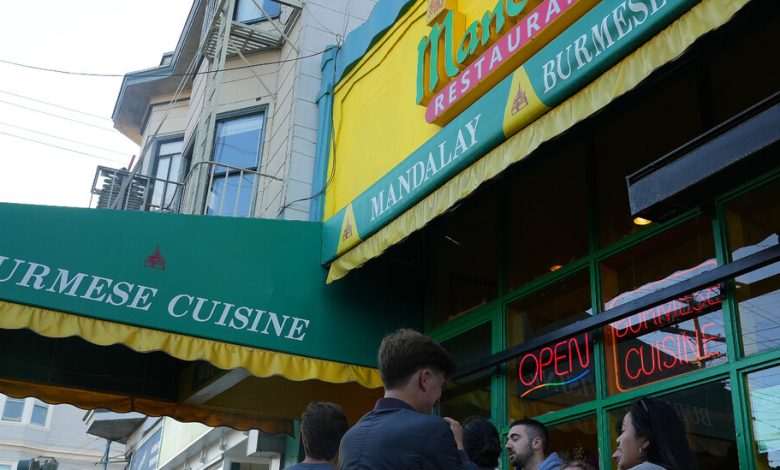How the Bay Area Became a Mecca of Burmese Cuisine

It’s Monday. How the Bay Area became a mecca of Burmese cuisine. Plus, understanding the allure of Montecito.

Mandalay opened in 1984 in the Inner Richmond neighborhood of San Francisco, an Asian American enclave sometimes called the city’s second Chinatown.Credit…Jim Wilson/The New York Times
The line to be seated at Mandalay, a decades-old Burmese restaurant in San Francisco, spilled onto the sidewalk on a recent Saturday evening. Inside the festive dining room, customers huddled around rainbow-colored tea leaf salads, spicy noodle soups and flaky parathas served with coconut dip.
A five-minute walk away, more would-be diners waited in the evening chill for a table at Burma Superstar, another popular restaurant serving a long menu of dishes from Myanmar, formerly known as Burma.
More than 10 eateries in the city specialize in Burmese food, at least by my count. In the larger Bay Area, there are dozens.
I was surprised to discover this. I recently moved to San Francisco En özel ve istanbul elit escort bayanları, ödeme elden seçeneğiyle hizmetinizde. from Los Angeles, where I almost never encountered Burmese food. The cuisine is a standby of the Bay Area’s culinary scene, with dishes like samusa soupand mohinga, a catfish stew,integrated into the region’s gastronomic vernacular.
So I was curious: How did this happen?
The legacy traces back at least 40 years, to Nan Yang, which opened in Oakland’s Chinatown in 1983. The restaurant, which closed in 2013, may have been the first full-fledged Burmese spot on the West Coast, The San Francisco Chronicle has reported.
Mandalay set up shop six months later, in the summer of 1984, on a quiet stretch of California Street in the Inner Richmond neighborhood of San Francisco, an Asian American neighborhood sometimes called the city’s second Chinatown.
“They wanted to introduce Burmese food to America,” Kevin Chen said of his family members who opened Mandalay. Chen took over the establishment, now the longest-operating Burmese restaurant in the Bay Area, from his uncle in 2003. “They started with a lot of difficulty — Americans didn’t know what Burmese food was.”
A wave of Burmese immigrants came to the United States after a 1962 military takeover of Burma’s government, and then again after a national uprising in 1988. By 1990, nearly two-thirds of U.S. immigrants from Myanmar lived in California, Jeanne Batalova, a senior policy analyst at the Migration Policy Institute, said.
Opening restaurants allows new immigrants to make a living, champion the food of their home country and create jobs for others from their community, she said. “It’s a very typical thing that immigrants often do,” she told me.
Sipping a cup of jasmine tea under purple and green parasols hung from the ceiling of his restaurant’s dining room, Chen told me that Burmese food was something of an amalgam of the flavors of India, Thailand and China, all of which border Myanmar. Many Americans are more familiar with those cuisines, which provided an entry point for San Franciscans. Early reviewers of Nan Yang and Mandalay relied on such touchstones to explain the restaurants’ stews and salads — and to help both restaurants attract legions of devotees.
“Without question, this is the best Burmese food I’ve ever eaten,” Bea Pixa wrote in The San Francisco Examiner in August 1984. “Honesty compels me to add that it’s also the first Burmese dinner I’ve ever eaten.”
But the success of a few Burmese restaurants in the 1980s doesn’t fully explain what’s going on now. According to Batalova, California’s Burmese immigrants are split about evenly between the Los Angeles region and the Bay Area. But so many more Burmese restaurants operate in the Bay Area.
For this final piece of the puzzle, we probably have to thank Burma Superstar.
The restaurant, on Clement Street in Inner Richmond, opened in 1992 but became a viral success after Joycelyn Lee bought it in 2000 with her husband at the time. Lee told me that when her family assumed ownership, Burmese food still felt like an uncomfortable novelty to many Americans. So she rebranded the dishes, pumped up the advertising, worked to attract American palates and sensibilities and spawned a new generation of Burmese restaurants in the Bay. Burma Superstar itself now has several spinoffs.
Without Burma Superstar, “I don’t believe we would have reached this level of popularity of Burmese food in the Bay Area,” Dennis Lin, who owns the nearby Burmese Kitchen, told The Infatuation. “All of our success goes back to what they were doing in the beginning.”
Chen also gives credit to Burma Superstar. But his restaurant retains its own longtime fans.
Many of Mandalay’s customers have moved to other parts of California, or to neighboring states, he told me. But when they visit family in the Bay Area, they always stop by Mandalay to have tea leaf salad or coconut chicken noodles. Burmese restaurants typically don’t exist in their new cities, he said.
They all tell him: “We miss your food.”
For more:
-
A guide to eating Burmese in the Bay, from Eater San Francisco.
-
The San Francisco Chronicle’s guide to the Bay Area’s best Burmese restaurants.
The rest of the news
-
One of California’s largest homeless encampments was shut down recently in Oakland, but the closure hasn’t solved the state’s problem with homelessness.
-
The California State Bar suspended more than 1,600 lawyers for violating rules that were devised after the Los Angeles lawyer Thomas Girardi was accused of stealing millions of dollars from his clients, The Los Angeles Times reports.
-
Firefighters are battling two big blazes in California, The Associated Press reports.
Southern California
-
Hollywood studios have begun removing big-budget movies from the 2023 release calendar because of the actors’ strike.
-
An appeals court ruled that the 2020 Los Angeles County criminal justice initiative known as Measure J, which would invest millions in housing, mental health services and jail diversion programs, is constitutional, The Los Angeles Times reports.
Central California
-
Oprah Winfrey, Gwyneth Paltrow, Ellen DeGeneres and other celebrities go to Montecito to escape the pressures of modern fame. What makes the place so special?
Northern California
-
Conflicting demands from BART and Berkeley have stalled a city plan to build 3,600 units of transit-oriented housing, The San Francisco Chronicle reports.
Where we’re traveling
Today’s tip comes from Neil Brown, who lives in Altadena. Neil recommends visiting the San Francisco Museum of Modern Art: “The (amazing!) Diego Rivera mural from the San Francisco Art Institute is on display at SFMOMA, and it’s on the ground floor, so no admission fee required!”
Tell us about your favorite places to visit in California. Email your suggestions to [email protected]. We’ll be sharing more in upcoming editions of the newsletter.
What we’re recommending
Fourteen new books coming in August.
And before you go, some good news
Marissa Bergmann was visiting New York from San Francisco in May 2021 when she met Retta Abraham. He sat down next to her at a rooftop party in Brooklyn and started chatting.
They turned out to have a lot in common. Their mothers are both of Japanese heritage, and their backgrounds had inspired in them both a vision of their future selves: to be surrounded by children and grandchildren.
Marissa, now 33, said that Retta, now 40, paused and reached out his hand: “Like in an old movie, he was like, ‘Do you want to fall in love?’” she said. “I wanted to say, ‘Yes, let’s do it,’ but I had to be cool, so I asked if we could dance first.”
They danced, and this month, they married.
Read their love story in The Times.
Thanks for reading. I’ll be back tomorrow. — Soumya
P.S. Here’s today’s Mini Crossword.
Briana Scalia contributed to California Today. You can reach the team at [email protected].
.





